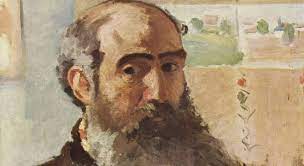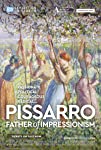Eye For Film >> Movies >> Pissarro: Father Of Impressionism (2022) Film Review
Pissarro: Father Of Impressionism
Reviewed by: Jennie Kermode

There’s a melancholy tone to this latest work from Exhibition On Screen which never really goes away. The familiar story of a talented artist who spent his life in poverty (losing three of his eight children along the way) because his commitment to developing new ideas and testing the boundaries of the possible was incompatible with commercial success. It’s a story, though, of a man whose influence not only resounded through the work of his fellow impressionists but can still be seen in art being produced today.
Combining the story of Camille Pissarro’s life with a tour of an exhibition of his work at Oxford’s Ashmolean Museum, as well as trips to see some of his other work elsewhere, this film is a rich portrait of a complicated man. It follows his journey from St Thomas in the Danish the West Indies, where he was born, to Venezuela, where he turned his back on privilege to seek inspiration, and then to France, where he exhibited in the Salon de Paris, attended the Académie Suisse and developed a close friendship with Paul Cézanne. Paintings of the Salon itself illustrate a section focused on what it meant to exhibit there at the time and what the experience of visiting it would have been like, but of course it wasn’t long before Pissarro’s inventiveness made it difficult for him to exhibit anywhere with real prestige, and even harder for him to sell his work at prices which might improve his lot. Much of the film is focused on this latter period and looks at why he chose the subjects and techniques he did, and what it means to the world today to have access to that legacy, a record of daily life from a time when, like today, most people preferred to focus on the glamorous life of the rich.
Listening to some of the contemporary criticism he received for his work, one cannot help but be reminded of online trolls. Much of what is said is equally unsophisticated and has a bullying tone, suggesting that the writers – some of them highly influential – hoped to hound out this upstart who caused discomfort by inviting people to see the world in a different way. It also helps to overcome the challenge of putting oneself in the position of somebody who had never seen that type of work before – someone who believed, for instance, that trees could only be rendered in shades of green and brown, and was therefore less able to notice the fantastic hues imparted by twilight, sunlight refracting off snow, or the glow of a fire. It reveals the magic which no longer has the same impact on our differently educated eyes.
This inventiveness aside, the standout feature of Pissarro’s work is his attention to detail and the structural acuity with which he captures landscapes and directs the eyes. Director David Bickerstaff enhances the effect of this through the use of a simple technique, focusing closely on one part of a painting and then shifting focus to reveal further details in the foreground or background, creating an almost three dimensional effect. It’s a great example of how viewing paintings through the medium of film can not only provide much wider access but can also add to the experience and more easily make one aware of what the painter was doing. Even if you’re able to see the Ashmolean exhibition in person, it’s well worth catching this film as well.
Pissarro’s choice of subjects gives us a window into rural life in the period, and the dignity he gives to peasants is striking in contrast to many works on similar themes. As in other Exhibition on Screen films, there is a lot of contextual imagery to help make this kind of thing visible. When it comes to the later, urban paintings, the artist’s habit of renting hotel rooms and capturing what he could see below him provides a very different perspective from most of what his peers were producing, with vistas which are almost cinematic themselves and which have a beguiling specificity about them.
This tendency to see things differently might be explained by the fact that Pissarro was himself an outsider, both as an immigrant and as a Jew. The film elucidates the tensions created within the impressionist group because it also included anti-Semites, and highlights some of the additional difficulties which this would have created in the artist’s career. Nevertheless, what ultimately emerges is a portrait of a singular individual whose biggest barrier to social acceptance was his genius, placing him very much ahead of his time. He may not, today, be among the most famous of the impressionists, but Bickerstaff makes it very clear that his work is deserving of attention.
Reviewed on: 24 May 2022

















